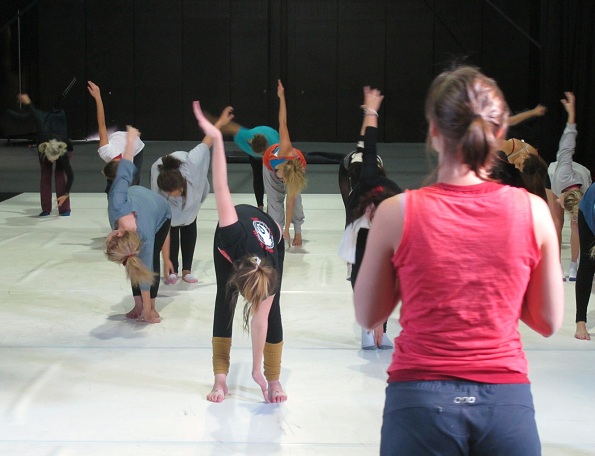By Rain Francis.
In 2014, all children will be entitled to study dance as a subject as part of The Australian Curriculum: The Arts: Dance. In order to prepare teachers to teach dance in their classrooms, Ausdance Victoria is offering a teaching series called “Dr. Dance.”
Developed by Dr. Katrina Rank, “Dr. Dance” will run as a pilot program in selected Victorian schools in 2013, and aims to provide generalist primary school teachers with the skills needed to teach dance to primary school students. Dance Informa’s Rain Francis spoke to Dr. Rank and her colleague, VET Coordinator Kate Kaleb, about The Australian Curriculum: The Arts.
This is exciting news. What do you think it will mean for dance, and for children?
Dr. Katrina Rank
My interest in the curriculum is for its creative and critical potential and in the ways it engages the whole student, kinaesthetically, kinetically, spatially, visually, inter and intra-personally. The Australian Curriculum: The Arts has a strong focus on students learning about dance by creating movement through improvisation and developing dances through choreographic processes, learning and consolidating dance skills and learning about performance by observing performances, presenting to others and reflecting on their dance experiences.
Kate Kaleb
One of the exciting aspects of the national curriculum is that children and young people are expected to be taught and to achieve fundamental motor skills. The development of physical skills is now recognised as being as important as cognitive and social skills. Fundamental motor skills are expected to be developed though dance and physical education, with key skills building progressively at each level of the curriculum. The dance-specific aspects of the curriculum are geared towards creating and responding to dance, which means there may be more opportunities for dance artists to work in schools as choreographers, teachers and performers.
Will the curriculum be taught in all Australian primary schools?
Dr. Katrina Rank
The Australian Curriculum states that all children are entitled to study dance. That’s quite a statement. All Australian students now have the opportunity to study dance through a curriculum that is consistent across states. However, it will not be compulsory. There are no hours set for dance.
Kate Kaleb
The national curriculum covers primary and lower secondary, up to Year 10. Each state will implement the national curriculum in it’s own way. Victoria has been quick to embrace the national curriculum. Other states may or may not be in the process of embedding it.
How has the “Dr. Dance” series been developed?
Dr. Katrina Rank
The “Dr. Dance” series is a training and professional support program for generalist primary school teachers who have an interest in teaching the new dance curriculum in their school. It is designed for people who have a strong enthusiasm and love of dance. They do not have to be experienced practitioners, but some dance experience, in any style, is best.
I have developed the program to cover basic dance theory, anatomy and childhood development, safe dance practice, foundation skills and how to teach them progressively, and basic choreographic skills. The program content is important, but so too is teachers’ availability. At present we’re looking to deliver the “Dr. Dance” series over seven two-hour sessions. I anticipate that teachers will want to extend their engagement and continue for another series of seven weeks.
What sort of dance will be taught in schools?
Dr. Katrina Rank
It will vary according to school and resources (mainly what teachers can offer), but I must stress that the curriculum is not going to be met if students only learn set dances, technique or motor skills. A major focus is learning through making and experiencing. If a child goes to art class and only ever learns how to cut and paste paper flowers, or painting by numbers, we would not accept that they were receiving a great art education. We would expect that the child expresses his or her own ideas and represents a worldview or perspective.
Kate Kaleb
A wide range of dance styles and dance philosophies will find a home in the classroom. What happens in an individual school will depend on the skills of the teachers and on the network of dance professionals they are able to access, as well as the needs of their student cohort. For instance, cultural dance is a great way for students to learn about other countries and for students from migrant backgrounds to develop their cultural identity. Hip-hop is great for developing physical skills and creativity (in coming up with your own moves), allowing students of all skill levels to be included. All dance styles can be used to tell stories and express emotions. The great thing about dance in a school setting is that all students can be included, whether they think of themselves as dancers or not.
Will teachers receive ongoing support from dance professionals?
Dr. Katrina Rank
We always encourage teachers to become Ausdance members, as through us they hear about many other wonderful opportunities provided by the dance profession. Ausdance Victoria is always finding new ways to support teachers and to develop resources that are fresh, innovative, useful and affordable. Over the past two years Ausdance Victoria has been working with other associations to produce digital and paper-based resources for teachers.
I am currently writing a book that guides generalist teachers through the major aspects of dance in the curriculum: preparing for a dance program, the body as the instrument of dance, the Elements of Dance, loads of practical activities and choreographic ideas for Foundation to Band 6. I also provide feedback to ACARA (Australian Curriculum, Assessment and Reporting Authority) on behalf of dance teachers. Whenever possible I make a call out for responses that I then collate, compare and feed back into the system.
If you are a teacher and are interested in finding out more about the “Dr. Dance” series, or have any questions, email education.vic@ausdance.org.au or call (03) 9689 2055.
Photo: Ausdance Victoria Industry Day. Photo by Claire Bradley.















